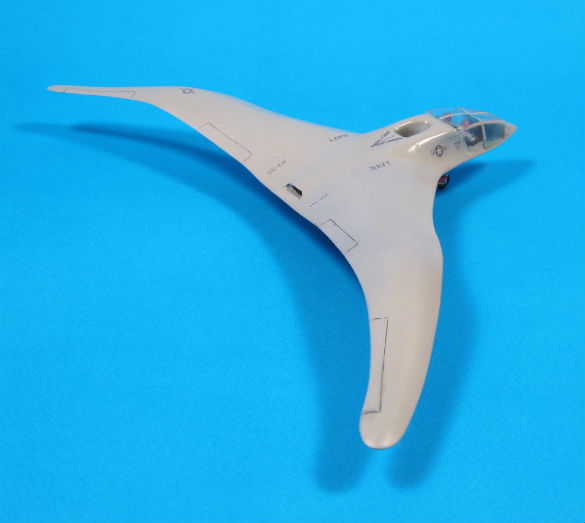Unacknowledged Aviation – Early Stealth Concepts Revealed

This article highlights three previously unknown military aircraft programs that originated in the early 1970s. Two of these programs utilized elements of stealth technology, which have been incorporated into modern low-observable aircraft and unmanned aerial vehicles. The third program brings to light a single-seat high-performance attack aircraft that used swing wings and angled sides to reduce its radar cross section (RCS). The drawings included in this article are based on original sketches provided by the senior project design engineers who worked on the programs. Although these historically significant aircraft programs were never built, they were officially funded by the U.S. government and are presented here to the general public for the very first time.

Silent Night
During the early years of the Vietnam War, American forces, flying F-4, F-100, and F-105 fighter/bomber aircraft, were experiencing heavy losses due to Soviet surface-to-air-missile sites and anti-aircraft artillery. In an effort to reverse this deadly trend, the Office of Naval Research proposed a feasibility research study to explore a low-RCS “stealth” attack aircraft that could neutralize these threats. The aircraft was specifically designed to address four important areas of stealth, which included, radar, infrared, acoustic, and visual. The government-funded program ran from 1971 to 1973. In February 1972, North American Aviation submitted a proposal for a naval attack aircraft referred to as “Silent Night.” The craft featured a tailless flying-wing configuration and a crew of two. The pilots sat side-by-side, although later variants included tandem seating. An asymmetrical canopy widow helped the weapons officer to identify targets.. Provisions for carrier operations included folding wings and a standard tail-hook with a pop up dorsal fin for directional stability.
To reduce the RCS, the Silent Night’s four-foot diameter twin-pack turbo-shaft-driven ducted fan engine was buried deep inside the body of the craft, with a single air-intake overhead. The craft featured tricycle landing gear, with provisions for either two AGM-65 Maverick surface-to-air missiles, or two AGM-78 standard anti-radiation missiles. A single Ka band mapping radar was located in its nose, which fed data to a 5” by 7” CRT screen. Silent Night had a wingspan of 70.71 feet and an overall length of 45.46 feet. Enthusiasts who follow the development of stealth aircraft will recall that Lockheed’s “Have Blue” prototype made its first flight on December 1, 1977 at Area-51. Although Silent Night was never built, North American Aviation’s concept predates Lockheed’s prototype by approximately three years, making it one of the very first government-funded stealth aircraft programs.

Flying Banana
The so-called “Flying Banana” was one of the first stealth aircraft programs to utilize smooth contouring along with twin-canted vertical stabilizers. The craft featured tricycle landing gear and a twin-pack turbo-shaft-driven four-foot diameter ducted fan for propulsion. Wing control surfaces were designed to be smoothly deflecting and seamless by the use of piezo-electric actuators. Use of off-the-shelf components to keeps costs down included a canopy from a Fury jet aircraft. The Flying Banana featured a wing span of 40 feet, and a length of 38 feet. The mission for the Flying Banana was defined as “low observable light attack” with an internal weapons bay.

Surprise Fighter
The “Surprise Fighter” was designed so that the wings could fold completely under the fuselage, like a stealth missile. In this configuration, lift for high speed flight (subsonic .95 Mach number) was provided by the shape of the fuselage. The craft featured a single overhead air-intake that fed a modified turbofan engine by way of an S-shaped duct. The flat-plate fuselage sides were angled in at 10 degrees to reduce the RCS. To reduce the infrared signature of the craft, an infrared suppression system was used, along with the mixing of outside cold air with the exhaust. A specially configured diffuser was used inside the exhaust port to prevent enemy radar from seeing the turbine blades from behind. The specific mission for the Surprise Fighter is still classified to this day, as are the RCS pole testing results per comments made by the senior project design engineer.

(Due to the classification level of stealth technology during the early 1970s, very little additional technical information regarding payload and range was available for the Flying Banana and Surprise Fighter programs. A detailed Freedom of Information Act request dated October 13, 2010 to the Office of Naval Research has gone unanswered as of this magazine’s publication date.)
This article originally appeared in Issue 6 of Open Minds Magazine. This issue is out of print.





I am Currently working on a Electro-gravitic drive, I have an 11 page Theory and would love to receive intelligent criticism. I have done extensive research on the subject and I believe I may have a obtainable design. If any interested parties would like to contact me my gmail will be in the description.
Tony, I have been following electro-gravitic drives for years. Please post and I’ll get back with you.
Tony G. – be careful who you invite to see your design plans.